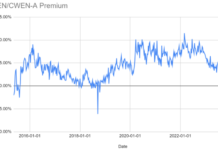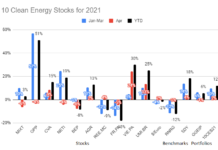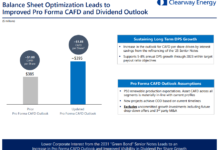Tom Konrad CFA
Sunpower and First Solar are indulging in nerd jokes.
Their YieldCo, called 8point3 Energy Partners had its initial public offering on June 19th. The name is an astronomy nerd joke and a reference to the time it takes the sun’s rays to reach the Earth, 8.3 minutes. Last week, we found out that its ticker symbol is CAFD, a “financial nerd joke” because it stands for “cash available for distribution.”
CAFD is an important YieldCo metric, but it’s not a perfect one. If you’re not a financial nerd but are interested in investing in YieldCos, here’s what you need to know to make sure the joke isn’t on you.
What is CAFD?
Cash available for distribution (CAFD) is a YieldCo’s estimate of how much of the cash from its assets is available after it has paid the cash expenses necessary to keep the company running. Such expenses mostly consist of interest and principal payments on debt and maintenance of facilities. Cash spent on new investments is also deducted, but this deduction is typically net of equity or debt financing.
CAFD is a “non-GAAP” measure, meaning it is defined by generally accepted accounting principles (GAAP), and so is not always comparable between YieldCos, as their definitions may vary slightly from the one above. Some YieldCos also use other names, such as “adjusted earnings per share” by NextEra Energy Partners (NEP) or “core earnings” used by Hannon Armstrong (HASI).
YieldCos are designed to return as much cash as they can to investors without compromising the company’s sustainability. Since there is no GAAP measure of how much cash a company can return to investors, they had to invent one. This is also a common practice among other income-oriented classes of securities such as REITs (“adjusted funds from operations”).
Strengths and weaknesses
Like any metric, CAFD has strengths and weaknesses. Its greatest strength is observability. Unlike GAAP measures like earnings, there is no need to estimate the likely life of an asset for purposes of depreciation, and no need to accrue expected future costs. Such estimates are intended to help earnings and other GAAP measures to reflect the true economic results of a company, but the very complexity of the rules often obscures as much as it reveals.
CAFD’s greatest weakness is that it is short-term in nature. While most YieldCo businesses are fairly stable, nothing is forever. Most YieldCo assets are long-lived, but even solar panels degrade slowly over time, and most wind turbines are designed to last around 20 years. Further, many YieldCo assets had been operating for some time before they were acquired.
Perhaps more important are the power-purchase agreements (PPAs) under which YieldCos sell the power they generate. These agreements typically have another 15 to 20 years to run, but many YieldCos seem to assume that they will be renewed on similar or even more advantageous terms when they expire.
Rules of thumb
Investors who want to choose between YieldCos should pay attention to CAFD per share and YieldCo CAFD per share growth targets, because dividends closely follow CAFD per share. But CAFD should not be the sole focus. They also need to understand how CAFD’s short-term nature will bias the comparisons between YieldCos.
Beyond higher current and future CAFD, investors should prefer
- YieldCos with longer-term PPAs
- Longer-lived assets (hydropower lasts longer than solar, which lasts longer than wind)
- Better-credit-quality power purchasers
- PPAs that sell power for close to the market price (because these are more likely to be renewed on favorable terms)
- Technologies which are not getting cheaper rapidly, or unique assets
- Dispatchable generation technologies
- Technologies that require fewer inputs (fossil fuels, water, biomass) that might cost more in the future
- Technologies that produce less pollution and are subject to potential regulation
PPA pricing risk
The problem for YieldCos that own assets which are getting rapidly cheaper lies in the prospects of PPA renewal. For example, solar photovoltaic system prices are universally expected to continue to decline (see chart below).
Today, a new utility-scale solar facility costs about $2,000 to $2,500 per kilowatt. It will produce about 1.2 megawatt-hours to 2 megawatt-hours per year per kilowatt, depending mostly on the local climate. Suppose we have a new solar facility that produces 1.5 megawatt-hours per year per kilowatt and which cost $2,250 per kilowatt to build. If various incentives cover half the cost, the facility would require a PPA at $67 per megawatt-hour to achieve a 9 percent CAFD yield.
Now consider what will happen in 15 years when the PPA expires. The facility will have degraded somewhat, reducing its output by 5 percent, maybe a little more. A new solar facility next door will be much cheaper, but will likely also qualify for far fewer incentives. If we assume that the new facility will cost $1,000 per kilowatt after (much-reduced) incentives, it would need a PPA at $59 per megawatt-hour to achieve the same to 9 percent CAFD yield. $1,000 per kW is a very conservative estimate for installed commercial solar costs in 2030 given that First Solar’s (FSLR) CEO expects that his company can hit that target by 2017.
If the customer can sign a PPA with a new solar farm at $59 per megawatt-hour, why would they sign a PPA with the old farm for more? After the 5 percent degradation and slightly higher maintenance costs for the older solar facility, a $59 per megawatt-hour PPA will only result in a 7.5 percent CAFD yield from a renewed PPA.
Hence, PPA prices for electricity from technologies like solar with rapidly declining costs are likely to fall as well. Since this effect may be partially offset by falling subsidies, YieldCos which own subsidized facilities may have an advantage if those subsidies are removed for future, competing facilities.
The weather-dependent nature of solar and wind is likely to exacerbate this problem. It used to be that solar production was well aligned with peak load on sunny summer afternoons. Now, locations with high solar penetration are beginning to experience a “duck curve,” with power prices dropping when solar production is at its peak.
In 15 years, when solar and wind PPAs will need to be renewed, it seems unlikely that utilities will be queuing up to purchase power that arrives when they need it least. Parts of the grid with high wind penetration already see zero or negative electricity prices at times of high wind and low electric demand, although grid expansion can alleviate this problem.
Such weather-related effects favor dispatchable technologies like natural-gas generation, but this advantage is offset by regulatory risk, because gas is a fossil fuel.
Technologies like hydroelectric and geothermal are likely to have th
e most durable pricing power. Not only do hydroelectric power plants usually last for 50 years, they typically have longer-term PPAs. They also have very little competition from new hydroelectric or geothermal plants nearby, because the best sites are already taken. Both hydro and geothermal have some potential for dispatchability, also reducing their long-term pricing risks, although resource risks from geothermal reservoir depletion and changing weather patterns should not be ignored for either.
Incentive distribution rights and dividend
Normally, a YieldCo’s dividend is directly linked to its CAFD because it will distribute all its cash available for distribution. Incentive distribution rights (IDRs) change this, because they allow for a larger share of CAFD to flow back to the YieldCo sponsor. YieldCos with IDRs include NextEra Energy Partners, TerraForm Power, Brookfield Renewable Energy Partners, and now 8point3.
CAFD is a great metric in that it gives investors a quick guide to what sort of dividend to expect in the short term. Given its short-term nature, this may be all that short-term investors and traders need. Income investors typically have a longer-term outlook. For them, it makes sense to look at the many factors detailed above which will affect a YieldCo’s dividend over the long term.
All clean energy technologies have risk, and we do not know which will be most important over the long term. Hence, it makes sense to diversify some of this risk away by including YieldCos which own less common clean energy technologies, such as geothermal, hydropower and energy efficiency.
There is not yet any publicly traded YieldCo which owns any geothermal assets, but both U.S. Geothermal and Alterra Power own geothermal assets, and could benefit if YieldCos seek to buy such assets to diversify their portfolios. Unfortunately for income investors, neither pays a dividend.
Both Brookfield Renewable Energy and Canadian power producer Innergex Renewable Energy own mostly hydroelectric facilities and pay healthy dividends. Alterra Power also owns hydroelectric facilities.
The unique sustainable infrastructure financier Hannon Armstrong has the most diverse portfolio, and is currently the only YieldCo with significant energy-efficiency investments.
***
Tom Konrad is a financial analyst, freelance writer, and portfolio manager specializing in renewable energy and energy efficiency. He’s also an editor at AltEnergyStocks.com.
Disclosure: Long Hannon Armstrong, Brookfield Renewable Energy Partners, Alterra Power, Innergex Renewable Energy, First Solar.
Note: The author of this article will be an instructor at EUCI’s “The Rise of The YieldCo” workshop on July 30-31. This article was first published on GreenTech Media and is reprinted with permission.
DISCLAIMER: Past performance is not a guarantee or a reliable indicator of future results. This article contains the current opinions of the author and such opinions are subject to change without notice. This article has been distributed for informational purposes only. Forecasts, estimates, and certain information contained herein should not be considered as investment advice or a recommendation of any particular security, strategy or investment product. Information contained herein has been obtained from sources believed to be reliable, but not guaranteed.









